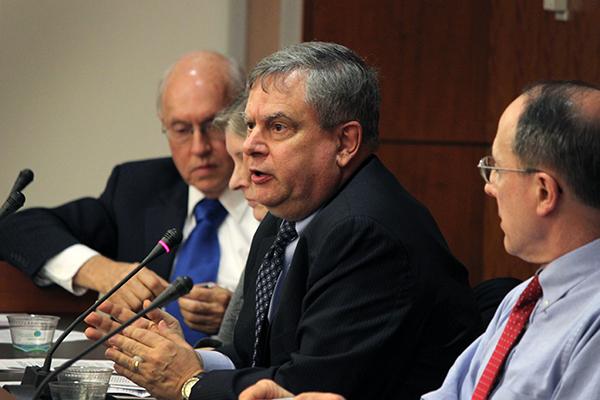Faculty and staff donated $8 million to the University last fiscal year, nearly two years into the public phase of GW’s $1 billion campaign.
Those donations are part of the efforts of the We Are GW Faculty and Staff Campaign – an arm of GW’s fundraising operation specifically focused on landing donations from GW employees, according to GW’s fundraising website. That faculty participation is an important element of the $1 billion campaign as officials have said in the past that faculty commitment helps reassure other potential donors from outside the University.
Vice President for Development and Alumni Relations Aristide Collins said in an email that faculty are some of GW’s “most important ambassadors” for the $1 billion campaign.
“They have unique connections to alumni they have taught and mentored, and as a result, they can help engage alumni in the life of GW,” Collins said.
The $8 million total was more than the previous fiscal year, according to the fundraising website. University spokesman Brett Zongker declined to say how many more donations have come in from faculty and staff since November.
Zongker said that about 20 percent of faculty and staff donate to GW each year, but officials have not asked faculty to donate more than usual or have changed their faculty fundraising strategy.
Philip Wirtz, a professor of decision sciences and psychology who has been at GW since 1968, said he has previously donated to the University to programs like business analytics and the psychology department.
“GW is my home. I want GW to succeed,” Wirtz said.
The faculty and staff committee is also made up of current employees, including Director of GW Housing and Financial Services Seth Weinshel, Assistant Vice President for District Relations Bernard Demczuk and Director of Career Services for the Graduate School of Political Management Mag Gottlieb, according to the fundraising website.
Charles Garris, a professor of mechanical and aerospace engineering who has taught at GW for more than 40 years, said that while donating is a personal choice, many faculty are eager to support GW.
”To show what’s exciting, and how we support our students, how we care about our students, how we make this a really great place to educate – these are the things that the faculty are really proud of, and they want to contribute,” Garris said.
Garris declined to say whether he had contributed to GW, but said that he makes contributions to his alma mater, the University at Stony Brook, State University of New York.
Garris, who is the chair of the Faculty Senate’s executive committee, said some faculty may already donate to other causes, making it difficult for them to also give to GW. He said some faculty also may be generally frustrated with the University because their health insurance premiums have risen 25 percent in the past three years.
“There are so many things you can give money to,” Garris said. “You can give money to curing cancer, to the Salvation Army, to homeless people – somehow GW has to fit within that spectrum.”
Fundraising experts said that whether or not a faculty member will decide to donate to their university depends on the level of connection they feel, a pattern that is also mirrored in the likelihood of alumni donating to their alma maters.
Adam Wilbur, the director of development for the University of Connecticut School of Business, said the faculty who are “the most involved” are also the “most likely to invest in the university.”
As a part of GW’s fundraising efforts, the deans of its 10 schools are required to spend 40 to 50 percent of their time fundraising. Deans, as well as University President Steven Knapp, often meet with alumni while traveling or may forge personal connections that can lead to donations.
For example, Lynn Goldman, the dean of the Milken Institute School of Public Health, helped officials land an $80 million gift that renamed the school and has also worked to secure naming gifts for the rooms inside its New Hampshire Avenue building.
Henry Nau, a professor of political science and international affairs, said he thinks that faculty should be asked to actively fundraise for GW instead of solely being asked to donate. During a book tour in 2013, Nau spoke with alumni about his research in an effort to solicit donations, but said he has not been asked to actively fundraise since.
“Development people and presidents of universities should familiarize themselves with who their key faculty are and then utilize them when they travel,” Nau said. “If you’re going to have an alumni event, feature a lecture by one of your outstanding faculty who has just published a book.”
Nau said faculty receive a letter from GW every year asking them to donate.
“I think most faculty, in modest amounts, are happy to contribute to annual campaigns,” Nau said. “I can’t say that I’ve done it every year, but it’s not something that I resist.”








